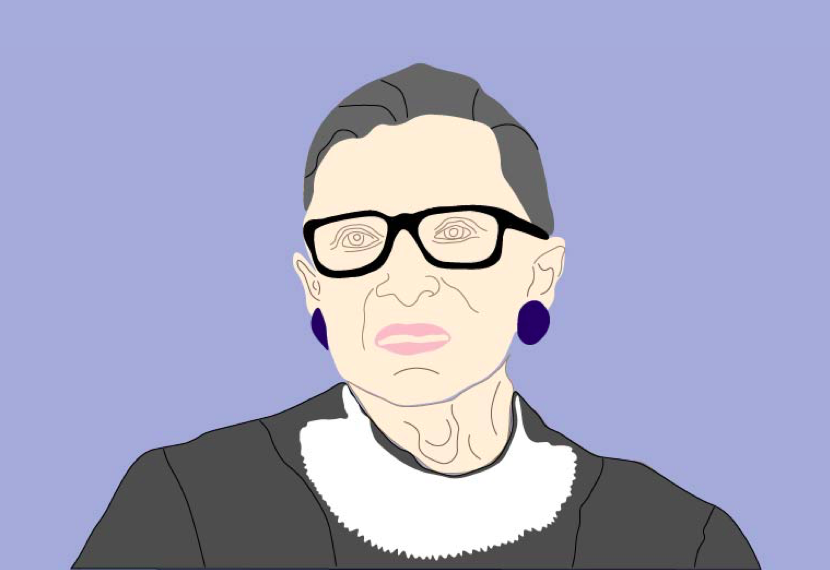the life and legacy of ruth bader ginsburg
By Isobel McCarthy / 26 September 2020

Illustration by Lena Blacker
The last few days for America, and subsequently the world, have been both a shock and an awakening. Ruth Bader Ginsburg, the pioneering late Supreme Court Justice and champion of justice has died aged 87, having served for 27 years as the second woman to reach the court.
Since her untimely death, thousands of people have flooded to city centres to pay respect for Ruth Bader Ginsburg and her remarkable career. She was laid in repose at the nation's highest court on Wednesday, making her only the second Supreme Court justice to receive such an honour. Ginsburg is a legendary figure, but it is important to explain why. Too often, influential people are celebrated and forgotten. But not Ginsburg. Her actions and rulings, as ascribed by Chief Supreme Court Justice John Roberts, have brought America "closer to equal justice under law".
Former President Bill Clinton, who nominated her to the Supreme Court, corroborates with Roberts, arguing that her "life and landmark opinions moved us closer to a more perfect union". She has undoubtedly set the democratic tone in America to be more "embracive", equal and consensus-building.
Ginsburg's Life Pre-Supreme Court
Ruth was born and bred in New York, Brooklyn, 1933, to Jewish parents. Her childhood friends, Ann Kittner and Harryette Helsel describe her as a "deep thinker" with a "quiet magnetism". Despite losing her sister at a young age and her mother when she was 17, Ginsburg remained determined to achieve her best. Undoubtedly, she is a formidably clever woman, using her drive and perseverance to land her a place at Cornell University, whereby she found herself outnumbered to men by 4 to 1.
During her time at Cornell, she met her husband, Martin Ginsburg, better known as Marty. Their 56-year love affair deserves its own story, but in summary, it was Marty's respect for Ruth's intelligence and independence that attracted her to him. They wed after University in 1954 into a 'marriage of equals', becoming parents to Jane and James. Whilst dealing with motherhood, Ruth then advanced on to Harvard Law School in 1956 before transferring to Columbia Law School – a class of over 500 with only nine women in. She graduated joint first in her class.
Ginsburg was no stranger to encounters of gender inequality or misogyny. Despite making the law review at both Harvard and Columbia law school, she was consistently rejected for prestigious judicial clerkship roles and excluded by law firms. In 1960, Supreme Court Justice Felix Frankfurter rejected Ginsburg for a clerkship position due to her gender.
In the notorious "RBG" Netflix documentary on Ginsburg's life, she described how an employee of Harvard University refused her entry to Lamont library on the basis of her gender. Women were not invited to the Harvard Law Review banquet, and not granted rooms in the Law School dormitories. It was only during the #MeToo era that she revealed she had turned down extra marks in chemistry at Cornell, in exchange for sex. These first-hand experiences of gender equality made Ginsburg aware of the issues at play. And she wasn't afraid to tackle them.
It was during Ginsberg's career as a law professor at Rutgers, New Jersey, Colombia, New York, and her work for the American Civil Liberties Union (ACLU) in the 1970s that placed her at the forefront of advocating for gender equality. Whilst director of the ACLU's Women Rights Project, Ginsburg argued six gender discrimination cases before the Supreme Court between 1973 and 1976, winning five.
What set her aside from other notorious judges, was the fact she distinctively applied the constitution itself to all her cases, creating a clear conviction of unequal treatment of women. Her most renowned case before the Supreme Court was the argument that gender discrimination was a violation of the constitution's equal protection clause. From this, she wrote the brief for Reed v. Reed, 1971, in which the Supreme Court extended the protections of the Equal Protection Clause of the Fourteenth Amendment to women.
It is fair to say that Ginsburg's petite and frail appearance stood in stark contrast to her actions and words. She had a vision and wouldn't bow down until it was implemented. In this case, she was patiently determined to ensure that gender would not remain an obstacle. For this to happen, she had to carry on fighting for the truth – as many say - "you can't speak TRUTH without RUTH".
Her combined perseverance, brainpower and legal skills led her to a seat on the United States Court of Appeals for the District of Columbia Court in 1980. Her seat terminated in 1993 when she rose to take her deserved place on the Supreme Court, having been nominated in by President Bill Clinton. The United States Senate confirmed her in by a 96-3 vote.
Ginsburg's Reign on The Supreme Court 1993-2020
One of Ginsburg's most renowned case whilst on the Supreme Court was that of the United States v. Virginia, 1996, whereby she struck down the Virginia Military Institute's male-only admissions policy. She stated that the state's military school "serves the state's sons" yet "makes no provision whatever for her daughters. That is not equal protection". The vote was 7-1; Scalia, her polar opposite friend, was the only judge to dissent.
Her ideological diligence in ensuring equality was again evident in 2013. She dissented in a case that invalidated a major portion of the 1965 Voting Rights Act, in Shelby Counter v Holder, 2013. She valiantly upheld her dissents throughout her reign but also remained bold during interviews. In July 2016, she complained to reporters about then-candidate Donald Trump, saying she could not take him seriously and that he was 'a faker'.
Ginsburg famously had reservations about Roe v. Wade 1973, but not for reasons that we would expect. In Roe v. Wade, the right to abortion is protected under a woman's right to privacy. Ginsburg viewed this as too easy and stated that the case attempted to do too much too fast. Her approach favoured a more incremental change; she wanted abortion protected under the 14th amendment rule. Whilst this would have been a harder precedent to implement and establish, it would have had the benefit of making it tougher for abortion right opponents to demolish, which is what we are starting to see now with a conservative fuelled majority court. Ginsburg's views on abortion only serve to exemplify her commitment to long-term gender equality.
The same commitment to gender equality applied to gay rights. During her last 15 years on the court, she played a significant role in upholding LGBT rights. Ginsburg's voice was hugely substantial in passing the right to marry the same sex, as evident in the United States vs Windsor 2013 case and Obergefell vs Hodges 2015. Ginsburg was the first supreme court justice to officiate a same-sex marriage in 2017. When asked recently during a public appearance how she wanted to be remembered, Ginsburg said, "As someone who did the best she could." I don't doubt that she gave it her best, but I doubt the extent to which she truly realises how much she has changed the course of American history.
Regardless of who replaces her, there will never be another Ginsburg to sit in the Supreme Court. The justices on the court describe her as "unfailingly gracious, thoughtful, and civil". Her perseverance and strength continue to have such an influential, positive and trailblazing effect on the lives of so many women and men. We should be eternally grateful that we lived through the era of the 'Notorious RBG'.
If you want to learn more about Ruth Bader Ginsberg, what the Netflix Documentary and listen to this podcast.
Art by
Words by
Share this article

